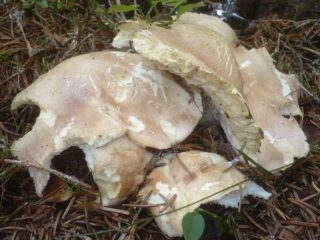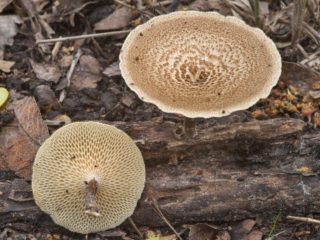Content
A mushroom listed in the Red Book that cannot be found in Russia is Tien Shan albatrellus. Its other name is Scutigertians chanicus or Albatrellus henanensis. It is an annual that does not grow in large groups and is rarely found on the plains.
Where does Tien Shan albatrellus grow?
The mushroom is found in the Tien Shan mountains, in the region of Kazakhstan and Kyrgyzstan. You can find it even on the highest peaks (2200 m), near their foot. Less commonly, this basidiomycete is found in the Great Alma-Ata Gorge. The species is not widespread in Russia.
Albatrellus Tien Shan bears fruit from July to August. The mycelium grows only in forest soil, near coniferous plants.The fruiting body is hidden in tall grass, where it is almost invisible.
What does Tien Shan albatrellus look like?
The cap of a young specimen is oblong, spread out, depressed in the center. Its dimensions do not exceed 10 cm in diameter. The edges are thin, uneven, wavy. The surface is dry, wrinkled, spotted, covered with dark scales. The color is dirty beige or yellow. In dry weather, the basidiomycete becomes fragile and brittle.

The leg is short, irregular in shape, up to 4 cm in length and no more than 1 cm in diameter
It is convex at the base, located in the center of the cap. The surface of the stem is smooth, but becomes wrinkled when dried.
Over time, the cap and stem practically grow together, forming a single fruiting body with many partitions.

In overripe Tien Shan albatrellus, the partitions dissolve, forming a single, loose fruiting body
The flesh of the mushroom is dirty white with a yellowish tint; the color does not change when dried. In older representatives of the species it is brittle and loose.
The tubes are short, thin, and practically indistinguishable. The hymenophore is brown with an ocher tint.
The pores are angular, rhombic. There are 2 or 3 of them per 1 mm of pulp.
The hyphal tissues are loose with thin septa. As they mature, they disappear completely. A brown resinous substance can be seen on the bluish tissues of the hyphae.
Is it possible to eat Tien Shan albatrellus?
Mushrooms belong to the group of conditionally edible forest products. The fruiting body can be eaten, but only at a young age. Old mushrooms become tough and inedible.
Taste qualities of mushroom
The fruiting body of the mountain basidiomycete does not have high taste qualities. It has no noticeable odor.It grows singly, and it is not possible to collect a full harvest.
False doubles
The described specimen has no poisonous counterparts. There are similar related species.
- Albatrellus blueporus is distinguished by the bluish color of the cap of young, immature mushrooms. It also differs in its place of growth: it is found in North America and the Far East.
The species is edible, but little studied
- Albatrellus confluent has a pinker and smoother cap. It grows in large groups that grow together into a single fruiting body.
This representative of the species is edible, but has a specific bitter taste.
Collection and use
Albatrellus Tien Shan begins to be collected in mid-summer. With the onset of autumn, the mycelium stops bearing fruit. Young, small-sized specimens are placed in the basket. It is not recommended to take old fruiting bodies - they are dry and hard. Picking a basket of these mushrooms is problematic, since they grow in a single copy and are well hidden in tall grass.
After collection, the fruit body is washed in running water and prepared to taste. It can be boiled or fried. They are stored in dried form for the winter. At the same time, the basidiomycete will not change its shape, consistency and color.
Conclusion
Albatellustian-shan is a rare, endangered species. Found only in the mountainous regions of Kazakhstan and Kyrgyzstan. In these countries it is listed in the Red Book. Finding it is considered a great success for lovers of quiet hunting. The mushroom described does not have high taste or nutritional value.










